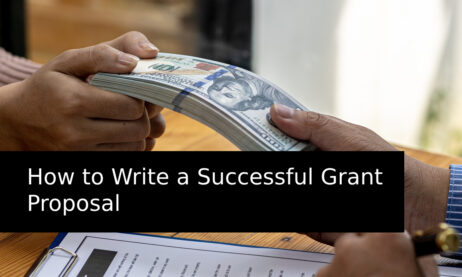Writing a grant proposal takes hours of work. Even then, there is no guarantee it will get accepted. With thousands of applicants, some don’t even get a second glance.
Don’t feel too discouraged, though, because there are ways you can have your grant proposal looked at and accepted.
With our step-by-step guide, you’ll know how to write a successful grant proposal in no time.
What is a Grant Proposal?
A grant proposal is a request for funds from a foundation or other grantee for a project or program. It could be a research, funding, social services, or scholarship grant proposal.
The proposal itself tells grantees why the funding is needed and what impact it will have on the wider community. It contains information about the individual, organization, and its projects, a problem statement, any evidence to back up its case, and a proposed budget.
For example, imagine you are a charity helpline stuck using an outdated system. Your office phone systems need updating so you’re able to contact vulnerable people who need your help. To apply for a grant you would need to write a proposal explaining why the charity is important and how vital an improved phone system would be to the community you serve.
Because foundations receive thousands of applications, this makes it difficult for grant proposals to stand out. Many don’t get past the cover letter – but let’s find out why.
Why Your Grant Proposal May Have Been Rejected
There are many reasons why a grant proposal is rejected, but the main ones are outlined below:

- The funder didn’t see your project’s potential: If you don’t explain the impact of your project, your grant proposal will fall flat. This could be on your organization, the wider community, the environment, etc. Show them the bigger picture, and you’ll have a much better chance of success.
- You weren’t clear about your organization’s needs: If you’re not clear about why you need funding, you won’t get it. Foundations prefer to allocate money to organizations that are clear about their needs.
- You didn’t meet the requirements: Always do your research before you apply for a grant. If you are looking for a grant for a freelance business there’s no point in applying for a grant that only accepts charities.
- You didn’t include the supporting documents: Evidence is crucial when applying for anything, so make sure you include all the documentation you may need.
- Your budget wasn’t detailed enough: You can never be too detailed when creating a budget. Before they hand out a grant, a person or organization wants to know exactly how you plan to spend their money.
Step-by-Step Guide for a Successful Grant Proposal
1- Grab their attention with a cover letter
This will give the potential grantee a first impression of you and your organization. The rest of your proposal will be more formal, and there will be a lot to get through. So you need to make them want to read on.
A cover letter gives you a chance to add a bit of human touch to the proposal and show the recipient what they’re about to read. You need to sum up who you are, why you need the money, and how much money you are asking for. Keep it short and to the point – you’ll have the opportunity to expand on your proposal in subsequent sections.

2 – Write a short executive summary
Before you dive into the details you should give a brief outline of the grant proposal. In no more than a couple of pages, you should introduce yourself or your organization properly and summarize your project goals. You can also show a simple budget outline, which you can expand on later.
This is your grant request. So, keep it formal and don’t add too many details. You should simply provide the grantee with enough information to understand why you need funds. Then, they can refer to the latter sections to get more information.
3 – Show your organization’s potential
If you want your grant proposal to be accepted, you need to make people believe in your organization. To do this they need to know as much about it as possible. When was it established? What’s its mission statement? Does it have any notable achievements?
Talk about past projects that relate to your current plans, and include any certifications or awards your organization may have received. Has there been anything in the media about your achievements? This is where you need your supporting documents.
You can even mention important staff members who will be working on the project. For example, in order to have the best people for your project you are planning to create a team with volunteers from around the country. It would be beneficial to note that your project leader already knows how to manage a remote team.
4 – Write a problem statement
A problem statement, or statement of need, highlights what problems you plan to solve with your project or program. It could be plans to set up a new community project, or even to renew a current program.
Remember to explain the problem clearly. You can include its impact on the community and any failed attempts to solve it in the past. You are more likely to get the attention of grantees if you have data to back up your claims.

5 – Explain your goals and objectives
Before you outline your plan, you should state your goals and objectives. Your goals should be outlined as broad statements that you want to achieve. The objectives should be more detailed and, most importantly, measurable. This makes it easier to track your success.
For example, a goal would be: “To set up a call center so volunteers can start fundraising”. An objective, on the other hand, would be: “To recruit five volunteers and train them to use the virtual phone for businesses and non-profits within two weeks.”
6 – Outline your project plan
If you want to know how to write a successful grant proposal, you need to be prepared to put together a compelling and comprehensive project plan.
A project plan is a detailed framework that shows exactly how you’re going to use the grant. It should include who is involved, such as staff, volunteers, and the public. You also want to talk about what methods you will be using. If you have experience from past projects, now’s the time to highlight it.
The plan also should link up with the objective and goals. What is your plan to achieve these goals? If you are planning on advertising online, include your social media strategy. If you need to hire transport, include quotes and bookings you have already set up. Make sure you have everything covered.
7 – Explain your evaluation plan
The deciding factor of a grant proposal could be your evaluation plan. Grants are large sums of money, so every penny needs to be accounted for. A grantee wants to know that you will be spending wisely, and making the most of the money. The only way to do this is to track the progress of your project as it is happening.
You need to show that you can measure your progress accurately and make adjustments if needed. There’s no point pretending everything will go to plan because that’s not how these things work.
One way to set out an evaluation plan is by creating a timeline. This way you can show how you’ll track your project as it progresses. A well-thought-out plan means that any issues can be found and fixed quickly. Now is the time to show off your project management skills.

8 – Show your sustainability
Knowing how to write a successful grant proposal also involves being able to show how solid and sustainable your company is.
A big mistake that some make with their grant proposals, in fact, is saying things like, “You’re our last hope” or “We can’t do this without you.” This doesn’t show a sustainable organization that has a long life ahead of it. You need to prove that you would still survive with or without this grant.
A good way to do this is to show other grants you’ve received, how you’ve used them, and what impact they’ve had. Show evidence of investors and other plans to get funds. You should be able to show a five-year plan of how the organization is going to progress.
For example, what is your onboarding strategy? Many charities take on volunteers and then train them for paid roles in the future. This is a sustainable way to recruit as employees will have more knowledge of the organization.
9 – Write a detailed budget
If they’ve read this far, your grantee is probably pretty invested in your organization. The final hurdle is the budget. Showing knowledge of cash flow is so important when creating a successful grant proposal. You want to demonstrate that you know how to allocate funds.
Write a detailed list of anything that will be purchased with the grant money. Include costs and, if possible, evidence of these costs. If you don’t know the exact prices, don’t be tempted to under-budget expenses as you’ll be caught out later. Also, don’t forget to double-check that your numbers are accurate.
Time to Write Your Winning Grant Proposal
Now you have our step-by-step guide on how to write a successful grant proposal, go back and do your research before you get started. Have all your paperwork in order before you begin. If you’re unsure of where to start, you can get started with a simple proposal template from Prospero. Then, get someone else to read over it before you send it off.

Don’t forget to finish your proposal with a professional sign-off. That’s your signature, full name and title, organization name, and contact details.
After this, you’ll be good to go – and best of luck with your grant proposal!




